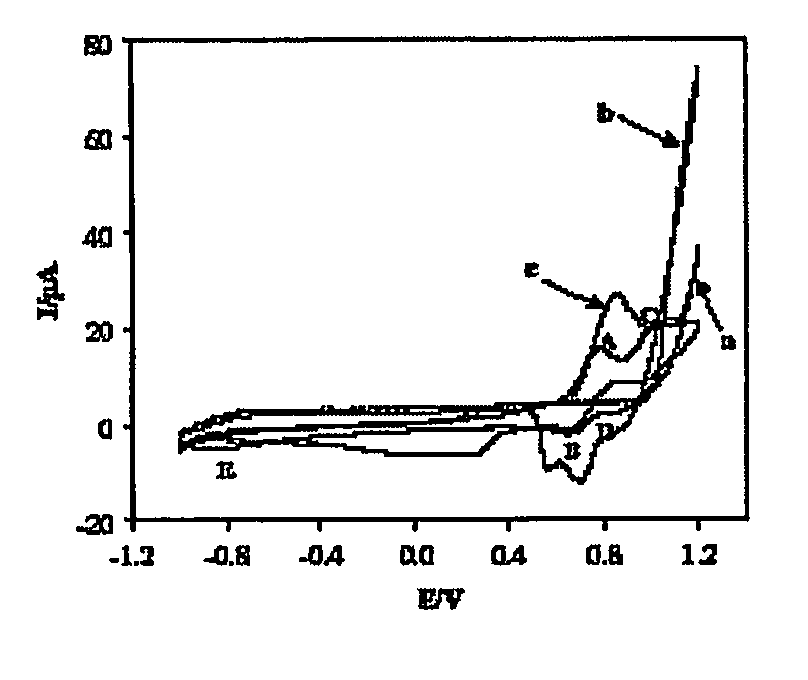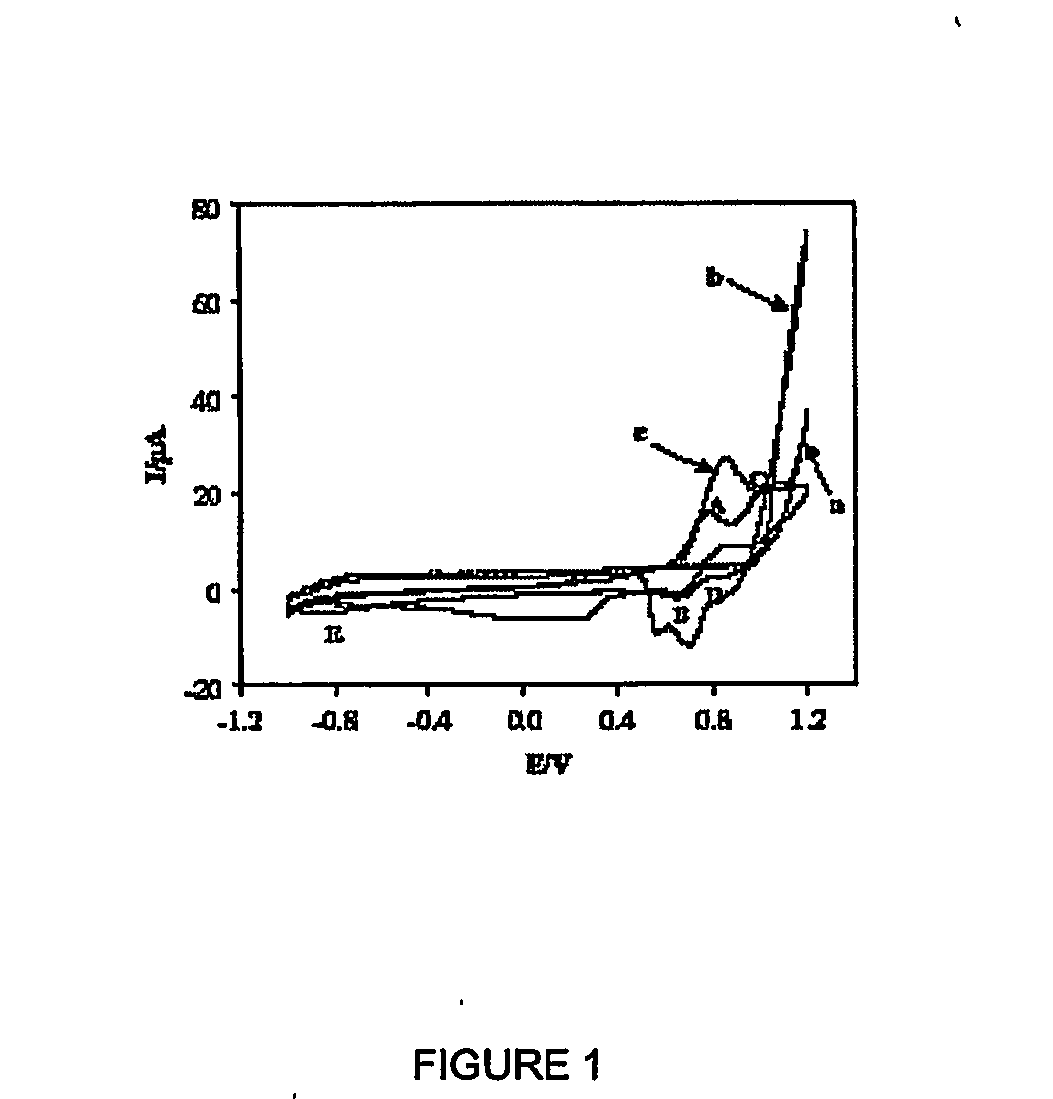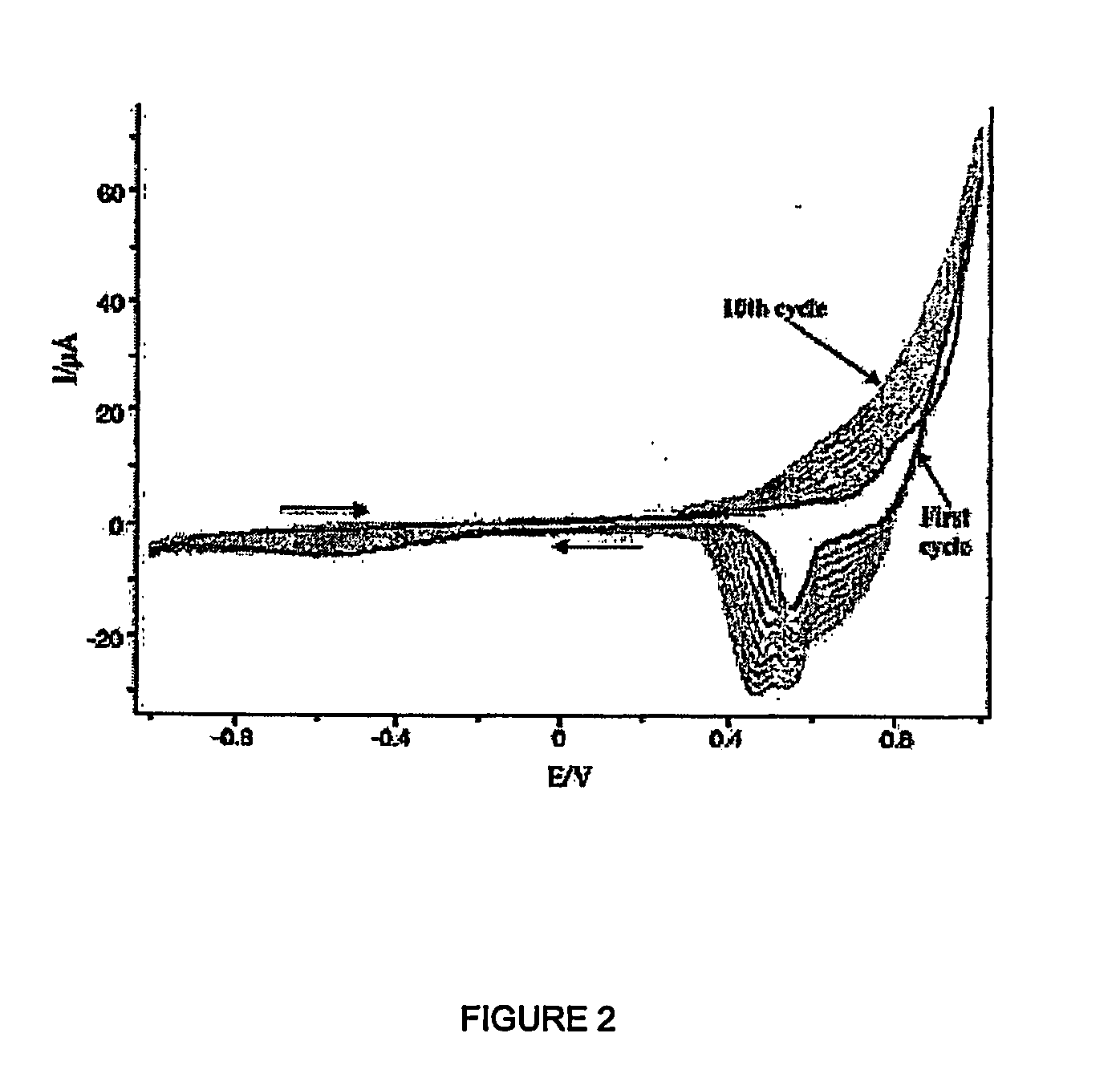Conducting Polymers With Porphyrin Cross-Linkers
- Summary
- Abstract
- Description
- Claims
- Application Information
AI Technical Summary
Benefits of technology
Problems solved by technology
Method used
Image
Examples
example 1
Synthesis of 5,15-Bis(3′-thienyl)-2,8,12,18-tetra-n-butyl-3,7,13,17-tetramethylporphine (I)
[0087] 3-Formylthiophene (30.6 mL, 0.349 mmol) and dipyrrylmethane (100 mg, 0.349 mmol) were dissolved in degassed anhydrous CH2Cl2 (35 mL) at room temperature. Then TFA (26.9 mL, 0.349 mmol, 1.0 equiv.) was added and the solution stirred under N2. At the first sign of baseline material by TLC (≈15 minutes; silica gel, CH2Cl2) the reaction was quenched by the addition of DBU (52.2 mL, 0.349 mmol, 1.0 equiv.). Then p-chloranil (214 mg, 0.873 mmol, 2.5 equiv.) was added and the solution stirred for 4 h at room temperature. Next Et3N (36 mL, 0.258 mmol) was added and reaction stirred vigorously for 1.5 h. Then excess Et3N (0.723 mL, 5.190 mmol) was added and reaction stirred for 15 min (forms complex with p-Chloranil that is soluble in methanol). The product was precipitated out of solution with methanol, filtered and dried under high vacuum to give product (I) (69.3 mg, 53%) as a purple crystal...
example 2
Synthesis of 5,15-Bis([2′,2″:5″,2″″-terthiophen]-3″-yl)-2,8,12,18-tetra-n-butyl-3,7,13,17-tetramethylporphine (III)
[0089] 3′-Formyl-2,2′:5′,2″-terthiophene (96.5 mg, 349 μmol) and dipyrrylmethane (100 mg, 349 μmol) were dissolved in degassed dry CH2Cl2 (35 mL) at RT. TFA (26.9 μL, 349 μmol, 1.0 eq) was added and the solution stirred under N2. At the first sign of baseline material by TLC (≈15 minutes; silica gel, CH2Cl2) the reaction was quenched by the adding DBU (52.2 μL 349 μmol, 1.0 eq). Then p-chloranil (214.5 mg, 873 μmol, 2.5 eq) was added and the solution stirred for 4 h at RT. Next Et3N (36 μL, 258 μmol) was added and reaction stirred vigorously for 1 h. Excess Et3N (723 μL, 5.190 mmol) was added and reaction stirred for 15 min. The product was then precipitated out of solution with MeOH, to give product (III) (76.9 mg, 41%) as a brownish-purple solid. 1H NMR (400 MHz, CDCl3, TMS): δ−2.309 (br d, 4H, [−2.304 (NH(αα or αβ)), −2.314 (NH(αβ or αα))]), 1.067 (t, 24H, 3J=7.3 Hz...
example 3
Synthesis of 5,15-Bis([2′,2″:5″,2″″-terthiophen]-3″-yl)-2,8,12,18-tetra-n-butyl-3,7,13,17-tetramethylporphyrinato zinc(II) (Zn-III)
[0090] A solution of Zn(OAc)2.2H2O (42.9 mg, 196 μmol, 1.2 eq) in MeOH (1.0 mL) was added to a solution of bisterthienylporphyrin (II) (177 mg, 163 μmol) in CHCl3 (18 mL) with stirring at RT. The reaction was deemed complete by TLC (Rf=0.25, silica, CH2Cl2:hexane (1:2)) after 30 min. The crude product was precipitated with MeOH and the resulting solid was recrystallised from CH2Cl2 / MeOH giving (Zn-III) (189 mg, 100%) as a brick-red powder. 1H NMR (400 MHz, CDCl3, TMS) δ 1.085 (t, 24H, 3J=7.3 Hz, CH2CH2CH2CH3), 1.68-1.79 (app sex, 16H, CH2CH2CH2CH3), 2.13-2.21 (app pent, 16H, CH2CH2CH2CH3), 2.915 (s, 24H, HMe-TBMP), 3.90-4.05 (m, 16H, CH2CH2CH2CH3), 6.34-6.44 (m, 8H, Hthienyl A), 6.78-6.80 (m, 4H, Hthienyl A), 7.12-7.15 (4H, [7.135 (dd, 3J=5.1, 3.7 Hz, H4″″ (αα or αβ)), 7.137 (dd, 3J=5.1, 3.7 Hz, H4″″ (αβ or αα)]), Hthienyl C), 7.28-7.31 [4H, [7.293 (dd,...
PUM
| Property | Measurement | Unit |
|---|---|---|
| Structure | aaaaa | aaaaa |
| Ratio | aaaaa | aaaaa |
| Electrical conductor | aaaaa | aaaaa |
Abstract
Description
Claims
Application Information
 Login to View More
Login to View More - R&D
- Intellectual Property
- Life Sciences
- Materials
- Tech Scout
- Unparalleled Data Quality
- Higher Quality Content
- 60% Fewer Hallucinations
Browse by: Latest US Patents, China's latest patents, Technical Efficacy Thesaurus, Application Domain, Technology Topic, Popular Technical Reports.
© 2025 PatSnap. All rights reserved.Legal|Privacy policy|Modern Slavery Act Transparency Statement|Sitemap|About US| Contact US: help@patsnap.com



